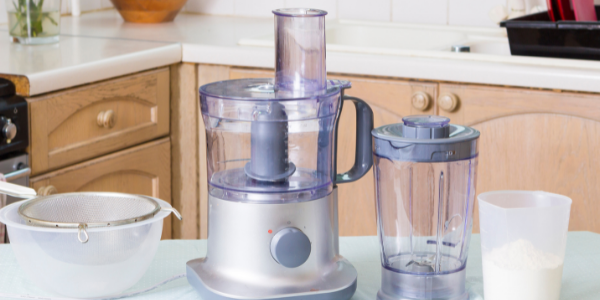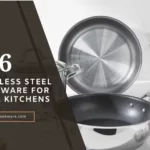Our site contains ads and uses Amazon affiliate links. We may earn a small commission at no extra cost to you. We know ads can be distracting, and we’re sorry for any inconvenience they cause. It helps us keep the site running. Thanks for your understanding and supporting us!
One of the best kitchen gadgets to have is a food processor. It makes cooking easier and more efficient by allowing you to chop, grate, slice, puree and mix ingredients in seconds.
You’ve probably seen those infomercials about how you can make all kinds of delicious dishes in just minutes with a food processor. But how do you use one properly? What are the benefits? And what is the best food processor for your budget and cooking style?
It doesn’t matter how experienced you are in the kitchen, a food processor can be an invaluable tool. It can help make your cooking and baking so much easier!
There are several ways to use a food processor safely. In this article, we will cover few proven ways to use a food processor.
Attachments You Can Expect from Your Food Processor
- Knife blade
- Dough hook or blade
- Shredding and slicing blades
- Grating blade
- Potato rasp
- Citrus press or juicer
- Mill
- Whisk
- Mini bowl
- Attachment storage box
- Spatula

How to Use the Different Parts of a Food Processor
A food processor is a kitchen appliance that can help you make dishes like pesto, pasta dough and salad dressing in seconds. It usually includes three parts:
- the bowl for cutting ingredients into smaller pieces;
- an insert with blades to chop them up even more finely;
- a blade or pusher attachment to push chopped ingredients out of the bowl.
What You Can Make with a Food Processor
Besides making salads, how else can you use a food processor? Here are 4 ways:
- Make pesto and pasta dough by pulsing the ingredients.
- Puree soups with the blade attachment to make them smoother.
- Chop up vegetables for stir fry.
- Combine cream cheese, salsa and olives in a food processor to create a tasty dip or sauce.
Function of a Food Processor (Chopping, Slicing, Grating)
- The slicer is best for slicing mushrooms and carrots.
- The grater attachment can grate hard cheese, citrus zest or ginger.
- To shred cabbage for coleslaw, use the chopping blade on a food processor to cut it into long strips before cooking in boiling water until tender.
- The shredding attachment is best for making fresh bread crumbs or finely grating vegetables.
- To create a silky smooth soup, use the blender to puree it first and then finish with the food processor using either the blade or metal chopping disk to further process.
- The blade attachment is great for chopping vegetables and mincing herbs – you can use it in multiple ways by moving the work around.
Do you need any other attachments in order to complete all these tasks?

A whisk attachment can be used as a substitute for an egg when baking a cake – but only if you do not have eggs available. A mini bowl will also help keep ingredients inside while pulsing so they don’t fly out of the work bowl, which is convenient when creating things like pesto sauce by hand without adding extra steps, such as transferring it to the food processor.
10 Vital Tips and Tricks for Using Food Processor
- Food processors are not just for making dishes; how about using it to grind your coffee beans?
- Don’t use a food processor on vegetables with skin, as this will cause the machine to bog down and can even risk serious injury.
- Process only one cup of liquid at a time or less in order to prevent overflow during pulsing.
- Process dry goods in batches or mix wet and dry ingredients together before pulsing to prevent howling.
- Put the lid on while processing so that food doesn’t fly out of the work bowl, which is convenient when creating things like pesto sauce by hand without adding extra steps such as transferring it to the food processor.
- Add the liquid first so that it doesn’t splatter.
- Remove the blade before adding ingredients to prevent howling and injury from spinning blades.
- Process a few pulses at a time until the desired consistency is achieved, then add more food if necessary for even distribution of ingredients in work bowl.

Cleaning Tips for Your Machine
- Clean your food processor every time you use it, even if there is little to no mess.
- Use a dishwasher soap or detergent with bleach and water for the blades and workbowls.
- For stubborn stains on the blade, scrub them off using warm soapy water before placing in the dishwasher.
- Clean the food processor base with a damp cloth or sponge.
- For small spills, wipe up any excess liquid and blot it dry.
- If necessary, use water to rinse off the blade before placing it in the dishwasher (this will remove any remaining food).
Storing Food Processor
The best way to store your food processor you buy is to keep it in its original box. This will protect the machine from any damage and also prevent dust or dirt from getting onto your food processor blades.
Bottom Line
You can use a food processor to create many different dishes. Using a food processor can save you time and make your cooking easier. If you want to make sure that your dish is healthy, try using the pulse button on your food processor if it has one.
This will give each ingredient just enough time in the blades without over-processing them and making them mushy or too small for chewing!
The article provides some excellent advice on how to use this appliance in the kitchen effectively. We hope that these simple instructions will help you get started!
Articles You’ll Also Like to Read
Best Cheese Slicer Reviews
Best Induction Cookware for Induction Cooking
Best Cast Iron Braiser
Best Knife for Skinning Cows





